Celestia Explained: Blobs, $TIA Tokenomics & More

Summary: Celestia is a modular crypto network that uses data availability sampling (DAS) to verify and permanently store transaction data. By separating consensus from execution, Celestia lets developers create blockchains without managing validators.
The native token, TIA, is used for transaction fees, staking rewards, and governance. Celestia’s ecosystem includes various decentralized apps and chains, such as Aevo, Orderly Network, and Ancient8, that rely on its data availability layer.
Celestia is the first modular blockchain that specializes in data availability, enabling developers to launch customized chains without managing validators or consensus mechanisms.
Data Availability
Permanently verifiable using Data Availability Sampling (DAS)
Developer Experience
Deploy modular chains easily without validators
Token Model
TIA token powers transaction fees, staking, and governance
What is Celestia?
Celestia is a modular blockchain that acts as a data availability (DA layer, enabling rollups and other blockchains to publish transaction data without their own validator sets. Unlike traditional chains, Celestia only orders transactions and ensures DA, decoupling consensus from execution.
It uses data availability sampling (DAS), a technique where nodes download small random portions of each block to efficiently verify DA. For example, nodes can verify block data availability with 99% certainty by sampling just 0.4% of the data, greatly reducing node requirements.
Celestia's modular design means developers can create custom blockchains without managing consensus or validators. Its scalability increases directly with the number of sampling nodes, allowing more transaction throughput as network participation grows.
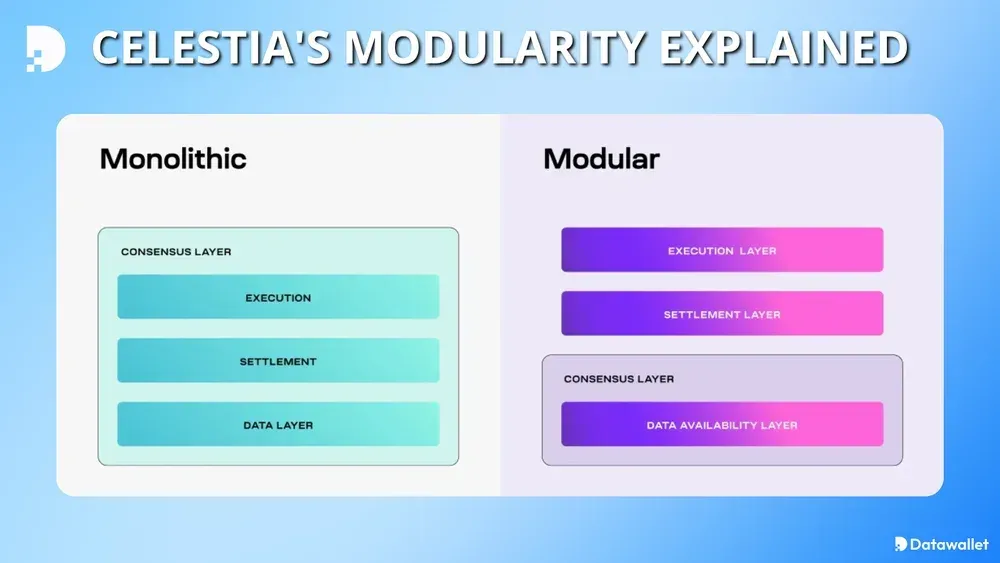
How Does Celestia Work?
Celestia works by assigning specialized blockchain functions (consensus, data availability, and execution) to different node types rather than performing all on a single layer. Each node type independently contributes to Celestia’s core functions, allowing greater modular scalability.
Celestia’s architecture has five core components:
- Data Availability Layer: Nodes ensure all transaction data is published and accessible by randomly sampling small subsets of erasure-coded block data.
- Namespace Merkle Trees (NMTs): Specialized Merkle trees group transactions by namespace identifiers, enabling nodes to efficiently query complete, application-specific data.
- Consensus Node Layer: Consensus nodes are exclusively responsible for ordering and broadcasting transactions without validating transaction correctness or execution logic.
- Storage Node Layer: Storage nodes maintain complete historical block data, providing proofs for queries of namespace-specific transactions requested by application nodes.
- Application Node Layer: Application nodes independently download, validate, and execute transactions relevant solely to their application's namespace, ignoring unrelated blockchain activity.
- Two-Dimensional Reed-Solomon Encoding: This method optimizes error detection and correction, ensuring data recovery even if parts of the data are missing or corrupted.
Note: Our breakdown of these functionalities is directly informed by a thorough analysis of Celestia’s official documentation and the original LazyLedger whitepaper authored by Mustafa Al-Bassam.
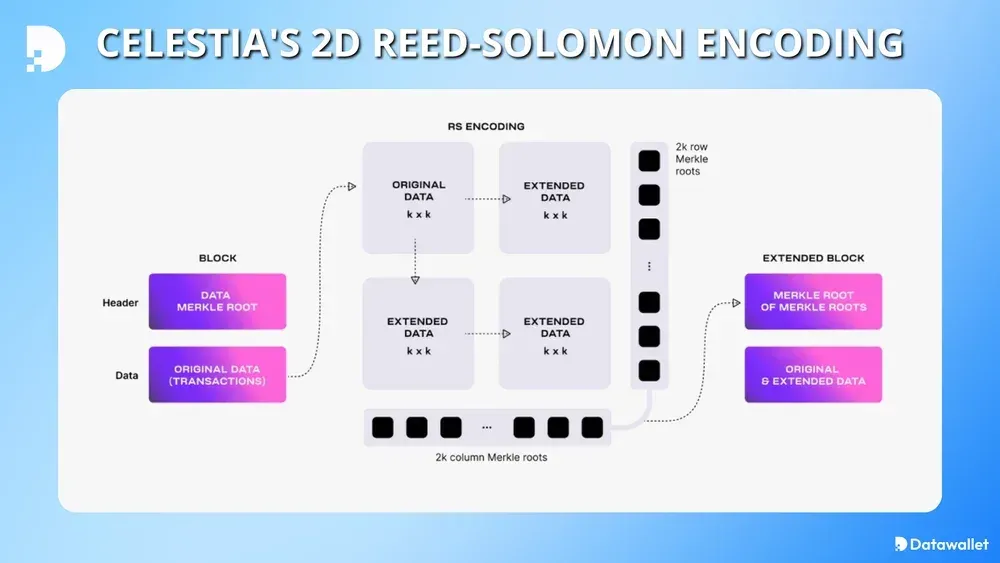
What is Data Availability?
Data availability is the guarantee that all blockchain transaction data is published and accessible, enabling independent verification by network participants. In monolithic blockchains like Bitcoin and Ethereum, verifying availability involves downloading entire blocks, becoming inefficient as data grows.
Celestia improves this using data availability sampling (DAS) and erasure coding, allowing full block reconstruction from just 50% of encoded data. This substantially reduces resource demands for verification compared to monolithic architectures.
According to data from growthepie.xyz, Celestia's DA layer has processed over 2.73 TB of transaction data since launch. The largest consumer is Eclipse, accounting for more than 2.39 TB, displaying Celestia’s ability to accommodate substantial blockchain usage.
What Apps and Chains Use Celestia for DA?
Celestia's data availability layer is increasingly adopted by Layer-2 networks, appchains, and decentralized applications (dApps) to securely scale transaction data. Using data gathered directly from Rollup.wtf, we've identified several active projects currently utilizing Celestia for DA, including:
- Aevo: A decentralized derivatives exchange running on its own Aevo L2, offering decentralized options and perpetual contract trading with on-chain settlement.
- Orderly Network: A decentralized trading infrastructure providing a permissionless liquidity layer and shared orderbook across multiple blockchains, enabling scalable decentralized exchange applications.
- Derive: A decentralized protocol built on Derive Chain, an Ethereum rollup, enabling trading of on-chain options, perpetual contracts, and structured financial products without traditional intermediaries.
- WINR Protocol: A decentralized protocol specialized for on-chain gaming and betting, providing infrastructure, liquidity, and decentralized governance for gaming operators and users.
- Ancient8: A gaming-focused Ethereum L2 built with the OP Stack, providing essential infrastructure and scalability tools to accelerate Web3 gaming adoption through its dedicated Ancient8 Chain.
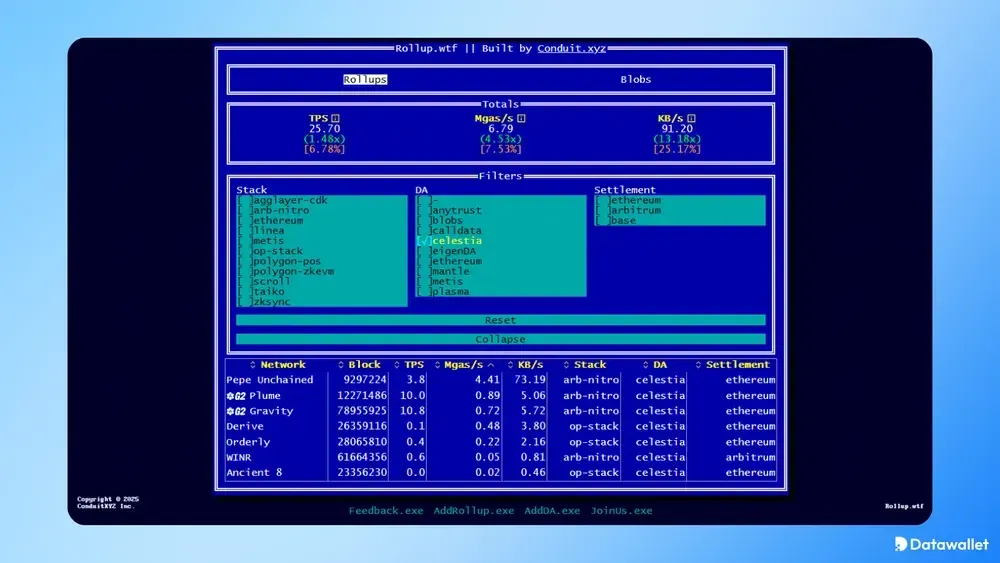
What are Blobs in Celestia?
Blobs in Celestia are discrete packages of data published via specialized transactions known as PayForBlobs. Each transaction splits into the blob, which includes the actual data tagged by its namespace, and a payment transaction containing the data’s cryptographic commitment.
Once submitted, blobs are placed within blocks under their respective namespaces and extended via erasure coding to ensure availability. The encoded blobs are then secured through Merkleization, creating a data root commitment that's included directly in the Celestia block header.
Unlike Ethereum’s temporary blob storage introduced in EIP-4844, Celestia’s blobs represent permanently available, verifiable units of data. Ethereum’s blobs are ephemeral, discarded after a set period, whereas Celestia maintains blobs indefinitely for ongoing verification.
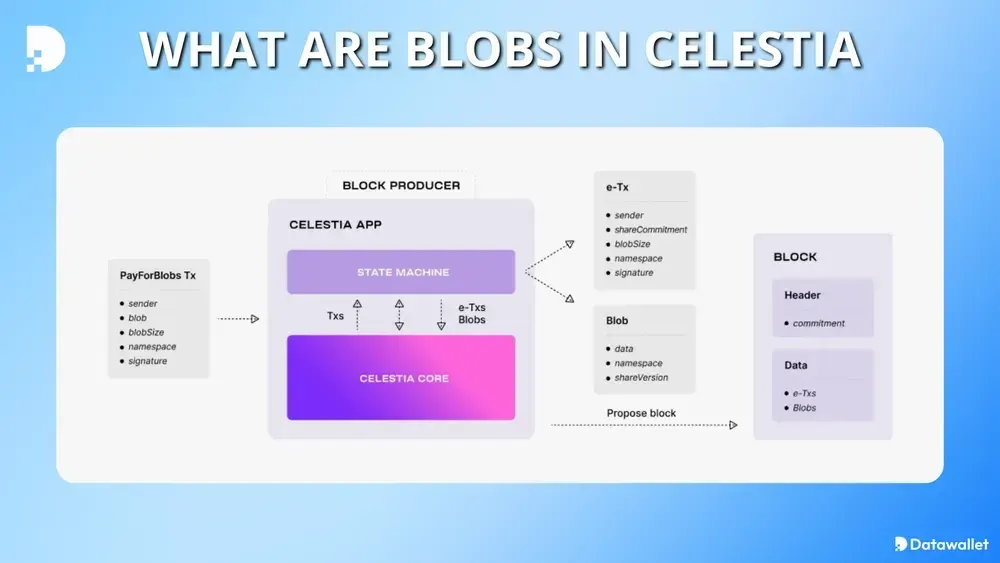
Celestia TIA Tokenomics
The tokenomics of Celestia’s native asset, TIA, provides the economic foundation for the network’s modular blockchain design. It has a total genesis supply of 1 billion tokens, with inflation beginning at 8% annually and gradually decreasing each year until stabilizing at 1.5%.
TIA token allocation at genesis:
- Public Allocation (20.00%): Distributed via a Genesis Drop, incentivized testnets for early users, and reserved tokens for future ecosystem initiatives driven by the Celestia community.
- R&D & Ecosystem (26.79%): Reserved by the Celestia Foundation and core developers to support long-term research, continuous protocol improvements, infrastructure expansion, and developer grants.
- Early Backers Series A&B (19.67%): Allocated to institutional and strategic investors who participated in Celestia's Series A and B funding rounds to provide early financial support.
- Early Backers Seed (15.90%): Assigned to foundational seed investors who backed Celestia during its earliest development stages, prior to wider public exposure.
- Initial Core Contributors (17.64%): Awarded to the Celestia Labs team members who actively contributed to the initial creation and launch of the Celestia network.
Our Take: Celestia’s tokenomics model is thoughtfully designed, with a substantial allocation dedicated to ecosystem growth and community initiatives, which we view positively. However, the relatively high portion reserved for early backers and initial contributors could initially limit broader decentralization.
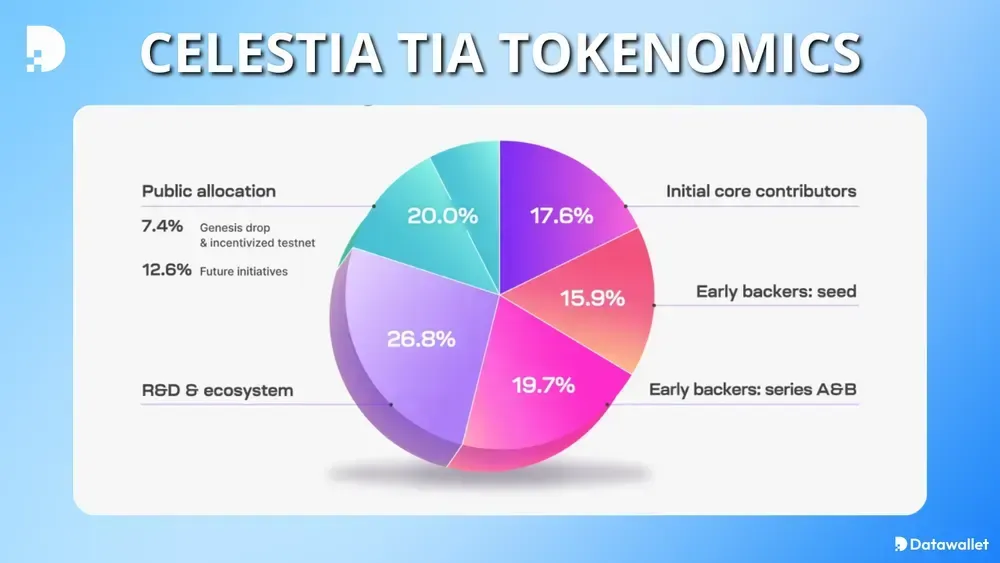
Celestia Founders
Celestia was co-founded by Dr. Mustafa Al-Bassam and Ismail Khoffi, serving respectively as CEO and CTO of Celestia Labs. Mustafa previously co-founded Chainspace (later acquired by Facebook) and holds a PhD in Computer Science ontributed as a senior engineer at Tendermint and the Interchain Foundation.
The Celestia Foundation, based in Liechtenstein, is governed by a council including the co-founders, entrepreneur Batuhan Dasgin, trustee Reinhold Wohlwend, and Web3 advocate Joon Kim. The Foundation funds decentralized research, ensuring Celestia stays credibly neutral and open-source.
Celestia vs Other Modular Blockchains
Celestia distinguishes itself from other modular blockchains, like Ethereum's rollup-centric design, primarily through its dedicated DA layer. While Ethereum temporarily stores blob data for rollups, Celestia permanently archives data for ongoing availability verification.
Unlike NEAR's Nightshade which provides temporary DA storage (around 60 hours), Celestia offers permanent, verifiable DA. This permanence enables Celestia users continuous independent verification, while NEAR optimizes primarily for efficiency.
Compared to EigenDA, Celestia prioritizes flexible, permanent data availability over EigenDA's high throughput (up to 50 MB/s) and Ethereum-based security model. EigenDA leverages restaked ETH, enhancing security but limiting users primarily to Ethereum-compatible ecosystems.
Avail provides rapid DA finality (around 40 seconds) and employs KZG validity proofs for efficient data sampling. Celestia similarly uses data sampling but uniquely emphasizes permanent data retention, making it preferable for applications requiring long-term data integrity.

Final Thoughts
Celestia’s approach of specializing in the data availability layer has already enabled projects like Manta Network to cut their fees by nearly 99.8% after leaving Ethereum.
The adoption by chains such as Aevo and Orderly Network further illustrates Celestia’s practical value to developers. While the initial token allocation raises some decentralization concerns, Celestia’s ecosystem growth and clear developer savings speak louder than any hype-driven narrative.
Frequently asked questions
How can users stake TIA tokens?
Users can stake their TIA tokens by delegating them to Celestia validators via wallets compatible with Cosmos SDK, such as Keplr or Leap Wallet, earning rewards and participating in governance.
Does Celestia support smart contracts directly?
No, Celestia itself doesn't execute smart contracts directly; instead, it provides a data availability layer for separate rollups or appchains, which handle smart contract execution independently.
What programming languages can developers use with Celestia?
Developers building rollups or appchains on Celestia can choose virtually any programming language, as execution occurs off-chain and Celestia's architecture doesn't impose specific language restrictions.
What is the Celestia Incentivized Testnet?
The Celestia Incentivized Testnet was a program where early network participants earned rewards for testing, running nodes, and helping to improve Celestia’s infrastructure before mainnet launch.
%25201%2520(1).webp)
Written by
Emily Shin
Research Analyst
Emily is passionate about Web 3 and has dedicated her writing to exploring decentralized finance, NFTs, GameFi, and the broader crypto culture. She excels at breaking down the complexities of these cutting-edge technologies, providing readers with clear and insightful explanations of their transformative power.

.webp)
%2520(1).webp)

.webp)
.webp)




